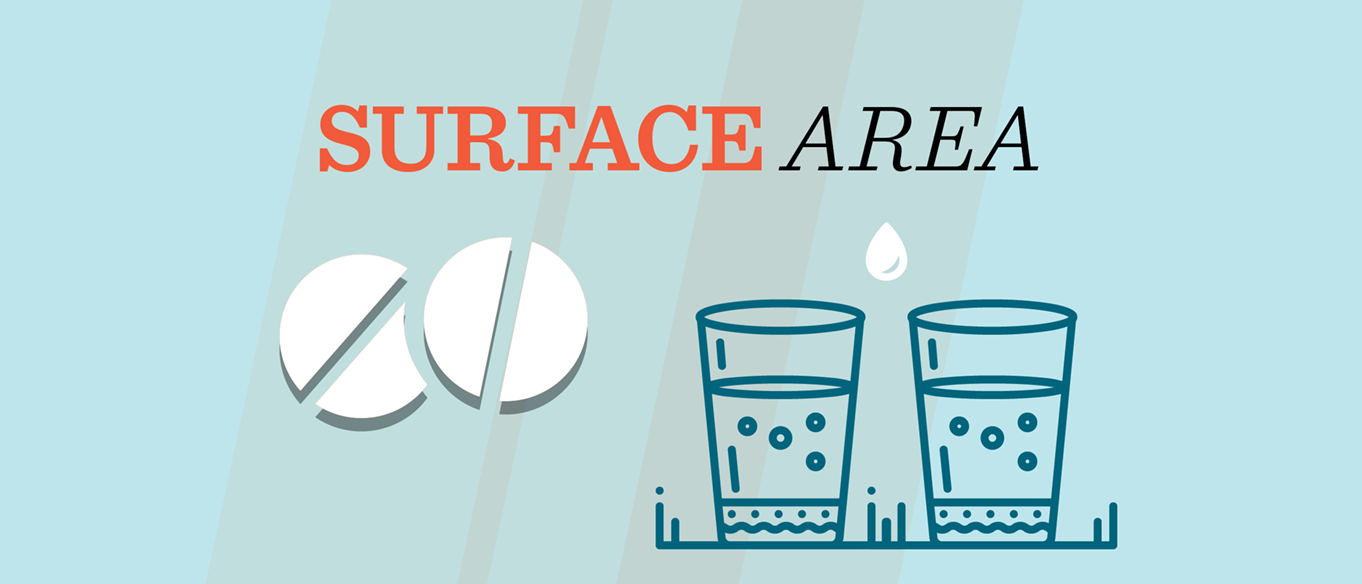
Explore how a material can act differently when it’s small than when it’s big. Test the reaction of fizzing antacid tablets in water and find out whether the size of the pieces makes a difference!
Age: 6+
Time: 15 minutes
Topics: antacid, surface area, chemistry, reaction
What you need:
- 2 matching clear glasses (small and narrow works best)
- Marker
- Masking tape
- Ruler or measuring tape
- 2 small measuring cups of the same size (¼ -½ cup works well), or 1 measuring cup and an extra cup or glass
- Pitcher or large cup for pouring
- Effervescent (fizzing) antacid tablets
- Water
- Food coloring (optional)
What to do:
1. Before you start this activity, do a little research. Put one antacid tablet on a plate or in a small bowl, drop or pour a tiny bit of water on it and make some observations about what happens. What did you see when you first put water on it? Did you hear anything? What happened to the tablet after a minute or two? Add a little bit more water, what happened next? Record your observations by taking a photo, drawing a picture, or writing some notes.
2. Turn your two matching glasses into measuring tools using the tape and ruler. Put a piece of tape lengthwise up the side of each glass, all the way from bottom to top. Use the ruler and marker to mark lines on the tape in one-inch increments starting from the bottom of the glass.
3. Fill the large cup or pitcher with water. If you like, add a few drops of food coloring to it to make the water easier to see.
4. Pour the water from the large cup or pitcher into each of the two measuring cups. Make sure both cups have the same amount of water in them. Tip: If you don’t have two measuring cups of the same size, fill the measuring cup once and empty it into an extra cup. Then fill the measuring cup again.
5. Take one antacid tablet and break it in half. Place both halves in one of the clear glasses. Break a second tablet into many small pieces and place that in the other clear glass.
6. Before you add the water, make a prediction about what you think will be different between the two glasses. Will one react more quickly? Will one have a bigger reaction?
7. Now, pick up the two measuring cups. At the same time, pour the water from each measuring cup into one of the glasses of antacid pieces.
8. Observe what happens in each glass. Check the measurement markings on the tape to see if they help you notice any differences. Record your observations as you did in Step 1.
- What did you notice? In what ways were the two reactions different?
- How did those observations compare to your predictions?
9. Other ideas to try:
- Try the experiment again, but carefully stir in a drop or two of liquid dish soap or hand soap to each measuring cup of water before adding it to the glasses. How does this change what you see?
- Try the experiment again with different sized antacid pieces, for example: a whole tablet, a tablet in four pieces, or crushed completely into a powder. Be sure to use the same amount of water each time. How do those sizes compare to the sizes in your first test?
- What other factors might affect the antacid tablet’s reaction? The amount of water, the temperature of the water, the shape of the container? Design an experiment to test one of those factors.
- Does surface area affect how other materials dissolve in water? Try comparing a whole sugar cube or piece of hard candy to one that is crushed into pieces. What other materials could you try?
What’s happening?
These antacid tablets fizz when they come in contact with water because of a chemical reaction. The water reacts with the tablet to create bubbles full of carbon dioxide gas. Chemistry has a lot to do with chemical reactions, but it also studies properties of materials. The property at work in this experiment is surface area. Small things have more surface area for their volume than larger things do. Some things that aren’t reactive at all in big pieces are very reactive when they’re tiny. The smaller the pieces of the tablet the faster it fizzes because the smaller pieces have more surface area. For the same amount of antacid, the crushed tablet has more surface, or exterior, to react with the water. Since the water can reach more of the tablet immediately, the reaction, or fizzing, happens faster.

